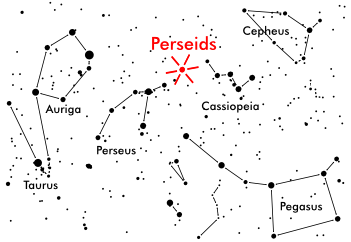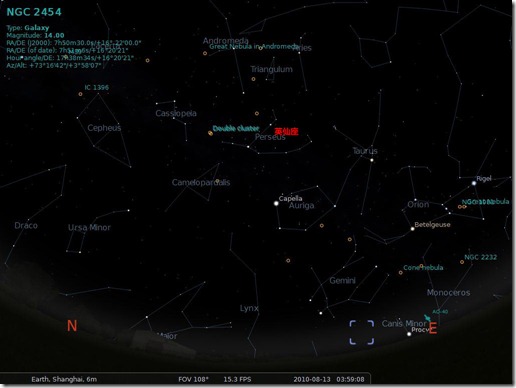2010年英仙座流星雨
2010年英仙座流星雨啊~
今年的预测是ZHR~100,预测峰值时间北京时间为8月13号凌晨的2点到15点。
关于月相情况(注意啊,今年月亮真是太给面子了哈)以及其他天象可以看:
http://multiverse.lamost.org/AstroCalendar.html
如何找到英仙座可以看下面的图,这个是上海地区2010-08-13,04:00的情况
==================================
来自IMO(英文下面有解释):
—————–
Perseids 2010

The Perseids are one of the most exciting and dynamic meteor showers; producing fast-moving shooting stars throughout July and August. Based on IMO observations from recent years, we expect the “normal” peak of ~100 meteors per hour to occur in the night of August 12-13 between 18h and 7h Universal Time.
The shower surprised on several occasions over the last two decades by showing outbursts of 150 to 400+ meteors/hour due to the Earth passing through regions of higher density in the dust stream. Simulations byMikhail Maslov and Jeremie Vaubaillon indicate that we may again encounter ‘dust trails’ this year, left behind in 441 and 1479, as well as denser regions due to perturbations of the stream by Saturn. Unfortunately, neither of these effects are expected to cause significant activity on top of the “normal” peak. Worldwide observations by amateur astronomers are required during all nights near the maximum to verify and improve these predictions.
New Moon on August 10 creates perfect conditions to observe the shower. Perseids are best observed after local midnight, when the radiant gains altitude in the sky. In fact, highest rates are visible towards the early morning hours when the radiant reaches its highest point. We strongly encourage visual observations to be made according to the standard procedure and submitted through the online report form. Such observations will automatically be included in the ZHR activity graph below (click for more results). Follow @IMOmeteorson Twitter to receive regular ZHR updates.
(如果您看不到图片,请直接点击看IMO网站的图片。)
此文大意告诉我们以下几点:
1. 英仙座流星雨时间是七八月份。
2. 英仙座流星雨的流星速度快。
3. IMO近几年的观测数据推测今年的流量在8月12号和13号的夜间的18点到7点(转换成北京时间为8月13号凌晨的2点到15点)达到100颗/小时(正常峰值)。预计不会有很大的反常。
4. 8月10号正好是新月。
5. 给出的图表是观测者提交的数据。显示了ZHR值(请看P.S. c条)
6. Mikhail Maslov 和 Jeremie Vaubaillon做的模拟显示我们今年可能又一次遇上了441年和1479年母流星留下的“尘埃尾迹”,而且也可能遇上了土星扰动所引起的大密度区域。但是这些都可能不会应起明显的超出正常峰值的活动。
P.S.
a. 关于英仙座:http://zh.wikipedia.org/zh/英仙座
b. 关于流星雨形成:http://zh.wikipedia.org/zh/流星雨
c. 关于ZHR:
每小时天顶流星数(ZHR,zenithal hourly rate )是用在流星雨观测上的一种观念,它代表的是在最佳状态下(如果辐射点位于天顶,天空中也没有光污染。)一位观测者可以看见的流星最多数量。
实际上,这里的最佳观测状态是有定量的,就是指在极限星等6.5的情况下,这种情况现在比较难遇到,也就是几乎没有光污染,而且观测者视力没有问题的时候,自然这里不能使用任何仪器。所以ZHR的意思就是说,在极限星等6.5的情况下,天顶的每小时流星数。还要解释一下每小时流星数的意思,实际上,这个值得出并不需要把一个小时的流星的数目加起来,而是最大的斜率的点,是最高瞬时值。这个学过一点高数的人应该都会懂。
所以说,不要指望会在一个小时内看到ZHR值数目的流星:我们的观测条件不够好,并且一般的极值不会持续一个小时。
d. 关于英仙座流星雨:http://zh.wikipedia.org/zh/英仙座流星雨
母天体是周期为133年的斯威夫特·塔特爾彗星。此彗星于1862年被路易斯·斯威夫特和塔特爾发现,之后意大利天文学家乔万尼·施亚帕雷利(Giovanni Schiaparelli)提出它可能是英仙座流星雨的母天体。这也是彗星首次被认定为流星雨的母天体。
e. 有很大的可能性你还不知道IMO!
International Meteor Organization,网站:http://www.imo.net/
国际流星组织,1998年建立,目前有250多位成员。IMO是为了响应流星爱好者的国际合作需求增加而建立的。
该组织网站提供了标准的观测方法和报表。
———————————————————————-
IMO的实时监测:
http://www.imo.net/live/perseids2010/
============================================
牧夫天文论坛的某帖子:http://www.astronomy.com.cn/bbs/viewthread.php?tid=142182
一年一度的英仙座流星雨已经来临,地球从今年7月17日至8月24日穿越英仙座流星群的轨道。据天文学会预告:今年英仙座流星雨的高峰期呈现在8月12日21时前后,全球最佳观测地点是美国的夏威夷群岛。在我国,可持续观测两个早晨:一个是8月12日早晨1时至天亮前;另一个是8月13日凌晨0时至天亮前。两个清晨:头一个凌晨我国东部地域基本不受月光影响,但观测到的流星数量相对较少;后一个清晨前半段稍受月光干扰,但观测到的流星数量相对较多。极大点估量:13日的0时40分和5时30分左右
英仙座流星有个特点——明亮的火流星,在天球上划出的长度比较长——特别是在其高峰时,午夜时分,辐射点刚从东北方升起来的时候,若能看到火流星,那么它就往往会在天上画出跨度超过100度的距离范围呀!
这个流星群的可观赏时间一般是从高峰前1–2天开始,直到高峰后3–4天,也就是说,长达一周的时间都是可以看到比较多的流星的(以上内容版权归广东南十字星秘书长星之芒果所有)。
———
这个不知道信息来源是什么。



想起来2004年去乌站看的就是英仙座流星雨,第一次看到火流星。
呵呵,那里应该条件不错吧~
今年应该还不错,正好算是新月吧~
哎,自从98、99连续两年冒着严寒看过狮子座流星雨,切身体会到什么叫流星暴雨后,对流星雨就再也没有多大兴趣了。这可怎么办呢?
去看看不同的流星有什么特点~
一边翻译IMO上的观测方法,一边学习如何科学观测流星雨。
呃,这个博客左右没有留白,感觉有些别扭……
现在改过来了~应该好多了吧~